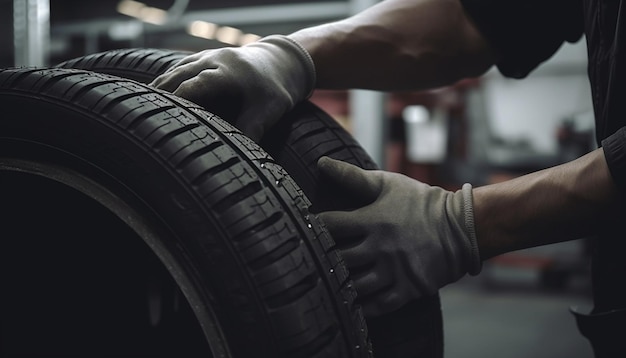
In the realm of car maintenance, few tasks are as simple yet impactful as checking tire pressure. This seemingly mundane practice goes a long way in ensuring your car's safety, performance, and fuel efficiency. However, neglecting this crucial step can lead to a multitude of problems, jeopardizing your safety and costing you more money in the long run.
This comprehensive guide dives deep into the importance of maintaining proper tire pressure and equips you with the knowledge and tools to keep your tires inflated optimally.
Why Maintaining Proper Tire Pressure Matters:
Enhanced Safety: Tires are the only point of contact between your car and the road, playing a vital role in maintaining control and stability. Underinflated tires have a larger contact patch with the road, leading to:
- Increased stopping distances: This can significantly compromise your ability to brake safely, especially during emergencies.
- Hydroplaning risk: Underinflated tires are more prone to losing traction on wet roads, potentially causing hydroplaning - a dangerous situation where the tires lose grip and the car skims across the water surface.
- Rollover risk: In extreme cases, underinflated tires can contribute to rollovers, particularly in situations involving sudden maneuvers or sharp turns.
Improved Fuel Efficiency: Properly inflated tires offer less rolling resistance, meaning your car's engine needs to work less to maintain speed. This translates to better fuel economy and translates to saving money at the pump. Studies show that underinflated tires can decrease fuel efficiency by as much as 3%.
Extended Tire Life: Maintaining proper pressure helps tires wear evenly, extending their lifespan and saving you money on frequent replacements. Underinflated tires experience more wear on the edges, leading to premature replacement.
Reduced Environmental Impact: Properly inflated tires contribute to lower emissions by improving fuel efficiency. This, in turn, helps reduce your car's environmental footprint and contributes to a cleaner environment.
How to Check Tire Pressure:
- Equipment: You'll need a reliable tire pressure gauge. Digital gauges are user-friendly and provide accurate readings.
- Frequency: Check tire pressure at least once a month and before long trips. It's also recommended to check pressure when there are significant changes in temperature, as air expands with heat and contracts with cold.
- Location: Locate the recommended tire pressure for your car. This information is typically found on a sticker inside the driver's door jamb, glove compartment, or owner's manual.
- Cold Tires: Always check pressure when the tires are cold, meaning the car has been parked for at least 3 hours or driven less than a mile.
- Process:
- Remove the valve cap from the tire stem.
- Press the gauge firmly onto the valve stem to form a seal and obtain the pressure reading.
- Compare the reading with the recommended pressure for your car.
- If the pressure is low, inflate the tire using an air pump until it reaches the recommended level.
- Re-check the pressure after inflation and replace the valve cap securely.
Additional Tips:
- Don't forget the spare tire: The spare tire also needs to be properly inflated for optimal performance in case of a flat.
- Use a TPMS (Tire Pressure Monitoring System): Consider having a Tire Pressure Monitoring System (TPMS) installed which can alert you to low tire pressure.
- Be mindful of temperature: As mentioned earlier, tire pressure fluctuates with temperature changes. Aim to check pressure when the ambient temperature is close to the temperature your car will be driven in most frequently.
Conclusion:
Maintaining proper tire pressure is a simple yet crucial practice that contributes significantly to your car's safety, fuel efficiency, and tire lifespan. By incorporating this routine into your car care regimen, you can ensure a safer driving experience, save money in the long run, and contribute to a cleaner environment.
Troubleshooting Common Tire Pressure Issues:

Maintaining proper tire pressure is crucial, but sometimes, you might encounter situations where the pressure drops unexpectedly. Here's how to handle some common tire pressure issues:
1. Slow Leaks:
Identifying the Leak: If you experience a gradual loss of pressure in one tire, it's likely a slow leak. Examine the tire for any punctures, cuts, or signs of damage. Look for bubbles forming around the valve stem when applying soapy water to the area.
Addressing the Leak: Small punctures can often be repaired by a professional using a patch or plug. However, if the damage is significant or involves the sidewall, replacing the tire might be necessary.
2. Rapid Pressure Loss:
Sudden Puncture: This can occur due to running over sharp objects like nails or debris. In such cases, the tire pressure will drop rapidly.
Immediate Action: Pull over to a safe location as soon as possible. If the puncture is small and isn't located on the sidewall, using a tire plug kit might be a temporary solution to get you to a repair shop. However, replacing the tire is generally recommended for safety reasons.
3. Pressure Fluctuations due to Temperature:
Seasonal Changes: As mentioned earlier, tire pressure varies with temperature. You might notice a slight drop in pressure during colder weather.
Adjusting for Temperature: Don't overinflate your tires to compensate for cold weather, as the pressure will naturally rise as the temperature increases. Instead, slightly adjust the pressure according to the manufacturer's recommendations for the expected ambient temperature.
4. TPMS Malfunction:
Warning Light: Your car's TPMS might malfunction and display a warning light even if the tire pressure is actually within the recommended range.
Checking the Tires: If the TPMS light comes on, it's still wise to visually inspect your tires and check the pressure manually using a gauge. You can also consult your car's owner's manual for troubleshooting steps related to the TPMS system.
Investing in Your Safety and Savings:
By understanding the importance of maintaining proper tire pressure and taking the necessary steps to check and adjust it regularly, you're not just making a responsible choice for your safety, but also saving money in the long run. Remember, properly inflated tires contribute to better fuel efficiency, extended tire life, and reduced environmental impact.
Make checking tire pressure a habitual part of your car care routine and enjoy the benefits of a safer, more efficient, and environmentally conscious driving experience!
No comments:
Post a Comment